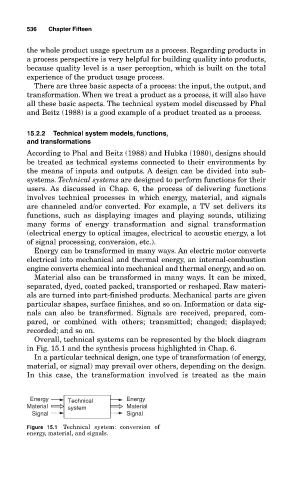Page 578 - Design for Six Sigma a Roadmap for Product Development
P. 578
536 Chapter Fifteen
the whole product usage spectrum as a process. Regarding products in
a process perspective is very helpful for building quality into products,
because quality level is a user perception, which is built on the total
experience of the product usage process.
There are three basic aspects of a process: the input, the output, and
transformation. When we treat a product as a process, it will also have
all these basic aspects. The technical system model discussed by Phal
and Beitz (1988) is a good example of a product treated as a process.
15.2.2 Technical system models, functions,
and transformations
According to Phal and Beitz (1988) and Hubka (1980), designs should
be treated as technical systems connected to their environments by
the means of inputs and outputs. A design can be divided into sub-
systems. Technical systems are designed to perform functions for their
users. As discussed in Chap. 6, the process of delivering functions
involves technical processes in which energy, material, and signals
are channeled and/or converted. For example, a TV set delivers its
functions, such as displaying images and playing sounds, utilizing
many forms of energy transformation and signal transformation
(electrical energy to optical images, electrical to acoustic energy, a lot
of signal processing, conversion, etc.).
Energy can be transformed in many ways. An electric motor converts
electrical into mechanical and thermal energy, an internal-combustion
engine converts chemical into mechanical and thermal energy, and so on.
Material also can be transformed in many ways. It can be mixed,
separated, dyed, coated packed, transported or reshaped. Raw materi-
als are turned into part-finished products. Mechanical parts are given
particular shapes, surface finishes, and so on. Information or data sig-
nals can also be transformed. Signals are received, prepared, com-
pared, or combined with others; transmitted; changed; displayed;
recorded; and so on.
Overall, technical systems can be represented by the block diagram
in Fig. 15.1 and the synthesis process highlighted in Chap. 6.
In a particular technical design, one type of transformation (of energy,
material, or signal) may prevail over others, depending on the design.
In this case, the transformation involved is treated as the main
Energy Technical Energy
Material system Material
Signal Signal
Figure 15.1 Technical system: conversion of
energy, material, and signals.

